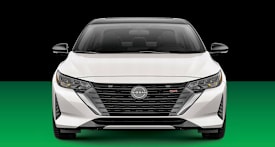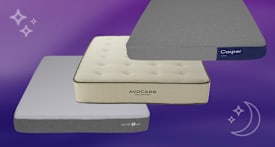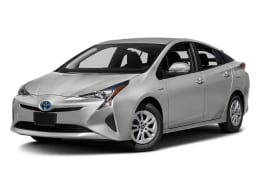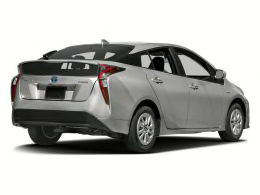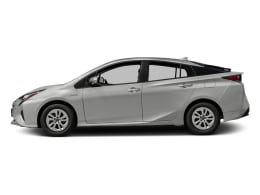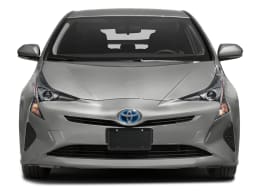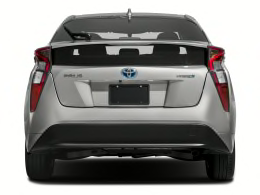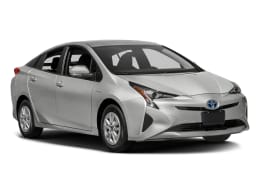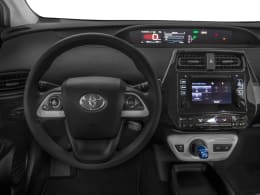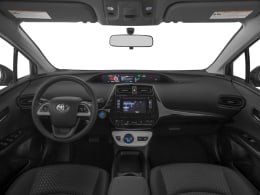Fifty-two mpg. Mic drop. The 52 mpg overall we garnered in the redesigned 2016 Toyota Prius is a phenomenal achievement, especially viewed against the previous car's impressive 44 mpg overall. In fact, it's the highest fuel economy we've ever recorded by a car that doesn't plug in.
There's more going on with the fourth-generation Prius than just fuel sipping, though. Sure, it still packs the traits Prius owners have come to love, such as interior room approaching a midsized car (within the footprint of a compact), hatchback versatility, and reasonable pricing. But some key weaknesses have been improved upon, including the ride, cabin noise, and interior quality. Plus, other common criticisms are addressed with zazzed-up handling dynamics and surprisingly aggressive styling.
Pricing starts at just under $26,000 for the base car. Our Prius Three landed at $27,323, putting it at parity with a typical midsized sedan or a small SUV. The Prius range tops out at nearly $31,000 for the Four Touring.
Although on paper the Prius' powertrain appears largely carryover, a number of small changes in key areas have had a big effect. For instance, the gasoline four-cylinder engine remains the same size as before -- 1.8-liters -- but it's now even more efficient. In fact, it's the most thermally efficient engine in a mass-produced car, according to Toyota. Meaning it more effectively turns fuel into motive force, rather than losing that gasoline-generated energy to heat.
For consumers, this technical achievement means the new Prius uses less fuel than the previous-generation model to achieve the same result. There's also an exhaust gas recirculation system, which allows the gas engine to shut down earlier and more often when it's not needed. Other mileage-boosting tricks include an efficient continuously variable transmission and a more aerodynamic body shape augmented by active grille shutters.
The car can run on electric power more often -- especially helpful in city driving. This enabled the Prius to achieve 43 mpg in our city cycle, versus the old car's 32 mpg. Highway fuel economy has improved from 55 to 59 mpg.
The lighter, more compact electric drive system teams with the gas engine to put out 121 horsepower combined -- down from the old car's 134 hp total. Toyota explains the difference is due to a different calculation method.
In most driving situations, the Prius has sufficient oomph, with the electric-drive torque giving a smooth start off the line. That said, it's still far from quick. Sprinting from 0-60 mph took a leisurely 10.3 seconds in our tests. The well-tuned CVT keeps engine revs at a reasonable level unless hard acceleration is called for.
The Prius is based on a new platform, with a more sophisticated independent rear suspension. The result is a ride that is both more comfortable and steady than the old car, and with less body roll in corners. Turn-in is prompt, and the Prius was secure and forgiving around our test track. Still, you won't mistake it for the more engaging Ford C-Max or Fusion Hybrid in terms of overall sharpness.
Brake feel is improved, too, and it's easier to modulate for smooth stops. While the brakes can feel a bit grabby at times, that immediacy is less than we find in most hybrids.
The car's low stance means you have to drop down into the front seat, but the reward is plenty of head room. The rear seat sees the most compromises, with a head-duck maneuver required to get in and less leg room than the outgoing car. Head room will be enough for most adults, though. Rear visibility is hampered due to a horizontal bar that splits the hatchback window.
Too bad the front seats aren't more supportive. They're fine for short drives, but the lack of lumbar support adjustment in most versions -- along with minimal door and center armrest padding -- compromises comfort on longer trips. Power lumbar adjustment comes with the power driver's seat and faux-leather upholstery in the Prius Four, making the seats more supportive -- but that's a $29,485 car.
The interior sees a major upgrade in terms of fit and finish. Gone is the hard, chintzy-feeling plastic trim that encased the cabin; instead, the 2016 Prius brings some soft-touch surfaces, flashes of chrome, and a modern, high-tech look. The white plastic surround below the console on our test car may not be to everyone's taste, though; we liken it to a Stormtrooper's bedpan. Other Prius oddities: the instrument panel is located in a center dashboard pod, and the transmission's shifter is more akin to a tiny, self-returning joystick. The shifter lacks some desired safeguards to prevent the car from rolling away if the driver opens the door with the car in gear.
The big news for 2017 is that all Prius models come standard with a comprehensive suite of active safety systems, called Toyota Safety Sense-P (TSS-P). This includes forward-collision warning, automatic emergency braking, lane-departure alert with steering assist, automatic high beams, and adaptive cruise control. Blind-spot monitoring remains optional.
Even with a few minor faults, this is the best Prius ever. Its fuel economy test results are a stunning achievement. Plus, the Prius is more pleasant to drive, and the interior has a quality feel more commensurate with its price. Unquestionably, the Toyota Prius sets the new standard for green machines and sensible transportation.
